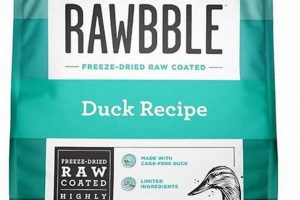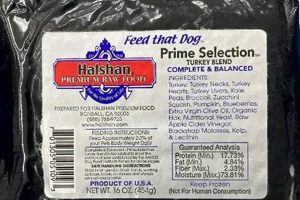Dietary management for canines diagnosed with inflammatory bowel disease (IBD) focuses on alleviating gastrointestinal inflammation and minimizing further irritation. The objective is to provide highly digestible ingredients, often novel proteins or hydrolyzed sources, alongside limited additives to reduce the likelihood of adverse reactions. These specialized formulations support optimal nutrient absorption and promote gut health in affected animals. For example, a prescription diet containing hydrolyzed chicken protein and prebiotics is often recommended.
Appropriate nutrition is a cornerstone of managing IBD in dogs. It can significantly reduce clinical signs such as vomiting, diarrhea, and weight loss, thereby improving the animal’s quality of life. Historically, dietary adjustments were largely empirical, relying on trial and error. However, advances in veterinary nutrition have led to the development of scientifically formulated diets tailored to address the specific needs of canines with this chronic condition, often incorporating ingredients with anti-inflammatory properties.
The following sections will delve into specific dietary considerations for canines experiencing IBD, including protein sources, carbohydrate options, the role of fiber, and the potential benefits of supplements. Additionally, the process of transitioning a dog onto a novel diet and the importance of long-term monitoring will be discussed.
Dietary Guidance for Managing Canine IBD
Implementing strategic feeding practices is paramount in mitigating the impact of inflammatory bowel disease in dogs. The following recommendations provide a framework for optimizing nutritional support.
Tip 1: Select Novel Protein Sources. Introducing a protein the canine has not previously been exposed to, such as venison, duck, or rabbit, can minimize the risk of triggering an immune response in the gastrointestinal tract. Ensure the selected protein is the primary ingredient and constitutes a significant portion of the food’s composition.
Tip 2: Opt for Hydrolyzed Protein Diets. These diets contain proteins that have been broken down into smaller peptides, reducing their allergenicity and improving digestibility. Hydrolyzed diets can be particularly beneficial for canines with severe IBD or those unresponsive to novel protein diets.
Tip 3: Incorporate Highly Digestible Carbohydrates. Rice, potatoes, and oats are generally well-tolerated and easily digested by dogs with IBD. Avoid grains like wheat, corn, and soy, as they may exacerbate inflammation in some individuals.
Tip 4: Consider Limited-Ingredient Diets. These diets minimize the number of ingredients, reducing the potential for allergic reactions or sensitivities. Scrutinize the ingredient list to ensure no common allergens are present.
Tip 5: Add Fiber Judiciously. While fiber can be beneficial for some dogs with IBD, it can worsen symptoms in others. Start with small amounts of soluble fiber, such as psyllium husk or beet pulp, and monitor the dog’s response closely. Insoluble fiber should generally be avoided.
Tip 6: Supplement with Omega-3 Fatty Acids. These fatty acids possess anti-inflammatory properties and can help reduce inflammation in the gastrointestinal tract. Fish oil or flaxseed oil are excellent sources of omega-3 fatty acids; consult a veterinarian for appropriate dosing.
Tip 7: Ensure Adequate Vitamin and Mineral Intake. Chronic inflammation can impair nutrient absorption, making vitamin and mineral supplementation necessary. A complete and balanced diet, potentially fortified with a multivitamin, is crucial to address potential deficiencies.
Adhering to these dietary guidelines can significantly improve the clinical signs associated with IBD in canines, promoting better digestive health and overall well-being.
The subsequent sections will explore advanced nutritional strategies and therapeutic interventions in managing severe or refractory cases of canine IBD.
1. Novel Proteins
In the context of dietary management for dogs with inflammatory bowel disease (IBD), novel proteins are a cornerstone strategy. Their implementation aims to reduce gastrointestinal inflammation and minimize immune responses associated with conventional protein sources.
- Reduced Antigenic Stimulation
Novel proteins, by definition, are protein sources that a dog has not been previously exposed to. This limits the likelihood of triggering an immune reaction within the gut, a common occurrence in IBD. By sidestepping pre-existing sensitivities, novel proteins contribute to decreased inflammation and improved digestive comfort. For example, switching from a chicken-based diet to one featuring kangaroo or rabbit as the primary protein source can often result in significant symptom reduction.
- Enhanced Digestibility
Some novel protein sources inherently possess higher digestibility compared to traditional proteins like beef or chicken. Easier digestion lessens the workload on the already compromised gastrointestinal tract of dogs with IBD. Sources such as fish (salmon, whitefish) or certain plant-based proteins (though less common) can be particularly gentle on the digestive system. This improved digestibility allows for better nutrient absorption and reduces the likelihood of undigested protein fragments exacerbating inflammation.
- Dietary Elimination Trials
The utilization of novel protein diets is integral to diagnostic elimination trials. By carefully introducing a single novel protein, veterinarians can assess a dog’s tolerance and identify potential protein allergens. This controlled approach helps pinpoint specific food sensitivities contributing to the IBD. If a dog shows marked improvement on a novel protein diet, it provides strong evidence that the original protein source was a trigger for the inflammatory response.
- Long-Term Management Strategies
Once a well-tolerated novel protein is identified through diagnostic testing, it can be incorporated into a long-term maintenance diet for dogs with IBD. Regularly feeding a diet based on this protein source helps prevent future flare-ups and maintain stable gastrointestinal health. Rotating between different novel protein sources, under veterinary guidance, can also minimize the potential for developing sensitivities to the primary novel protein over time.
In essence, the judicious selection and implementation of novel proteins are crucial to the successful dietary management of IBD in dogs. By minimizing antigenic stimulation, enhancing digestibility, aiding in diagnostic testing, and supporting long-term maintenance, these proteins play a vital role in alleviating symptoms and promoting overall well-being.
2. Hydrolyzed Diets
Hydrolyzed diets represent a specialized nutritional approach in managing canine inflammatory bowel disease (IBD). These diets are formulated with proteins that have undergone a process called hydrolysis, wherein the protein molecules are broken down into smaller peptides and amino acids.
- Reduced Antigenicity
The primary advantage of hydrolyzed diets lies in their reduced antigenicity. The hydrolysis process diminishes the ability of the protein to trigger an immune response in the gastrointestinal tract. This is particularly beneficial for dogs with IBD, where the immune system overreacts to dietary antigens, leading to inflammation and associated clinical signs. By minimizing this immune stimulation, hydrolyzed diets can effectively reduce the severity of IBD symptoms.
- Enhanced Digestibility and Absorption
Hydrolyzed proteins are generally easier to digest and absorb compared to intact proteins. The smaller peptide and amino acid size allows for more efficient uptake across the intestinal lining, even in dogs with compromised digestive function due to IBD. This improved digestibility ensures better nutrient utilization and reduces the likelihood of undigested protein contributing to inflammation in the gut lumen.
- Diagnostic and Therapeutic Utility
Hydrolyzed diets serve as valuable tools in both the diagnosis and management of IBD. They are often employed in dietary elimination trials to differentiate food sensitivities from other underlying causes of gastrointestinal distress. A positive response to a hydrolyzed diet suggests that dietary protein is a contributing factor to the dog’s IBD. Furthermore, these diets can be used long-term as a therapeutic strategy to control symptoms and prevent disease flares.
- Considerations for Palatability and Formulation
While hydrolyzed diets offer significant benefits, palatability can sometimes be a concern due to the altered protein structure. Manufacturers often employ techniques to enhance the taste and acceptance of these diets. Additionally, hydrolyzed diets should be formulated to provide complete and balanced nutrition, ensuring that all essential nutrients are present in adequate amounts to support the dog’s overall health.
In conclusion, hydrolyzed diets represent a well-established and evidence-based dietary intervention for managing IBD in dogs. By reducing antigenicity, enhancing digestibility, and serving as both a diagnostic and therapeutic tool, these diets contribute significantly to improved gastrointestinal health and enhanced quality of life in affected animals.
3. Digestible Carbohydrates
In the context of canine inflammatory bowel disease (IBD), the selection of digestible carbohydrates within formulated diets assumes critical importance. IBD is characterized by chronic inflammation of the gastrointestinal tract, often resulting in impaired digestion and nutrient absorption. Consequently, the type of carbohydrate included in the diet can significantly impact the severity of clinical signs and the overall well-being of the affected animal. Easily digestible carbohydrates minimize the burden on a compromised digestive system, facilitating efficient energy extraction and reducing the potential for undigested residues to exacerbate inflammation. For instance, a diet incorporating rice or potato as the primary carbohydrate source is generally preferred over one containing wheat or corn, as the latter are more likely to trigger adverse reactions or be poorly digested.
The inclusion of digestible carbohydrates directly influences several key aspects of managing IBD through diet. Firstly, they provide a readily available energy source, crucial for maintaining body weight and supporting metabolic functions in dogs often experiencing malabsorption. Secondly, they minimize the osmotic load in the intestinal lumen, reducing the likelihood of diarrhea, a common symptom of IBD. Thirdly, fermentation of certain digestible carbohydrates, like beet pulp (a source of soluble fiber), can produce short-chain fatty acids (SCFAs), which nourish colonocytes and contribute to gut health. A practical example is the use of prescription diets specifically formulated for IBD, which often utilize easily digestible carbohydrate sources in conjunction with novel or hydrolyzed proteins to achieve synergistic benefits. The effectiveness of such diets highlights the direct link between carbohydrate digestibility and the successful management of IBD.
In summary, the strategic incorporation of digestible carbohydrates is an indispensable component of dietary management for canines with IBD. Their selection contributes to improved energy availability, reduced gastrointestinal distress, and promotion of gut health. Recognizing the importance of carbohydrate digestibility enables veterinarians and owners to make informed decisions regarding dietary choices, ultimately leading to improved clinical outcomes for dogs suffering from this chronic condition. Challenges remain in identifying the optimal carbohydrate source for individual animals, necessitating careful monitoring and potential dietary adjustments based on the dog’s response. However, the fundamental principle of prioritizing digestibility remains a cornerstone of effective IBD management.
4. Limited Ingredients
The concept of “limited ingredients” in canine diets gains particular relevance in the management of inflammatory bowel disease (IBD). A strategic reduction in the number of components aims to minimize potential allergenic or irritating substances, thereby alleviating gastrointestinal inflammation and associated clinical signs. The rationale centers on the principle that fewer ingredients equate to a decreased probability of encountering an antigen that triggers an adverse immune response within the digestive tract.
- Reduced Antigenic Load
Limiting the ingredient list inherently reduces the antigenic load on the gastrointestinal system. This is especially beneficial for canines with IBD, where the immune system is often hypersensitive to dietary components. By minimizing the number of potentially problematic ingredients, the likelihood of triggering an inflammatory cascade is reduced. A diet with only a single protein and carbohydrate source exemplifies this approach, starkly contrasting with conventional diets containing a multitude of ingredients, many of which are unnecessary fillers or potential allergens.
- Simplified Digestion
Diets with fewer ingredients are often easier for dogs to digest, particularly those with compromised digestive function due to IBD. A simpler composition minimizes the enzymatic requirements for breakdown and absorption, potentially reducing the workload on an already stressed digestive system. An example includes avoiding complex carbohydrates and focusing on highly digestible starches, alongside a single, easily processed protein source, facilitating more efficient nutrient uptake and reducing undigested residue that could contribute to inflammation.
- Facilitated Identification of Allergens
Should a dog on a limited ingredient diet still exhibit adverse reactions, identifying the causative agent becomes significantly easier. With fewer ingredients to consider, the process of elimination and reintroduction is streamlined, allowing veterinarians and owners to more readily pinpoint specific allergens or sensitivities. In contrast, a complex diet necessitates a far more involved and time-consuming process of identifying the offending ingredient, hindering timely intervention and prolonged discomfort for the animal.
- Improved Management of Food Sensitivities
Limited ingredient diets enable precise control over the dietary components, crucial for managing known food sensitivities or allergies in dogs with IBD. By deliberately excluding identified allergens and focusing on well-tolerated ingredients, a tailored diet can be formulated to minimize inflammation and maintain gastrointestinal health. This targeted approach stands in stark contrast to generic diets, which may inadvertently contain hidden allergens or ingredients that exacerbate symptoms in sensitive individuals.
In conclusion, the emphasis on “limited ingredients” in formulating food for dogs with IBD stems from the need to minimize antigenic stimulation, simplify digestion, facilitate allergen identification, and improve the overall management of food sensitivities. The strategic reduction of ingredients supports a more controlled and predictable dietary approach, ultimately contributing to improved clinical outcomes and enhanced quality of life for affected canines. The practice of carefully scrutinizing food labels and collaborating with a veterinary nutritionist is paramount in effectively implementing this strategy.
5. Soluble Fiber
Soluble fiber, a type of dietary fiber that dissolves in water, forming a gel-like substance in the digestive tract, plays a multifaceted role in the dietary management of canine inflammatory bowel disease (IBD). Its inclusion in food for dogs with IBD stems from its ability to modulate gastrointestinal function and support a balanced gut microbiome. The gel-forming property slows gastric emptying, promoting satiety and potentially reducing the frequency of defecation, a common symptom of IBD. Furthermore, soluble fiber can bind bile acids, preventing their reabsorption in the small intestine and potentially lowering cholesterol levels. A real-life example is the addition of psyllium husk, a rich source of soluble fiber, to a dog’s diet, which can help to normalize stool consistency, alleviating both diarrhea and constipation associated with IBD. This practical significance underscores the importance of understanding the mechanisms by which soluble fiber exerts its beneficial effects.
The bacterial fermentation of soluble fiber in the colon produces short-chain fatty acids (SCFAs), notably butyrate, acetate, and propionate. These SCFAs serve as a primary energy source for colonocytes, the cells lining the colon, thereby promoting gut health and potentially reducing inflammation. Butyrate, in particular, exhibits anti-inflammatory properties and has been shown to enhance the integrity of the intestinal barrier, preventing the translocation of harmful bacteria and toxins into the bloodstream. Beet pulp, often included in canine IBD diets, is another source of soluble fiber that supports SCFA production. Diets enriched with soluble fiber have demonstrated improvements in colonic health and function in dogs with experimentally induced colitis, highlighting its therapeutic potential. However, it is crucial to note that the optimal amount of soluble fiber varies among individuals, and excessive intake can lead to gas production and abdominal discomfort. Therefore, careful titration is often necessary.
In summary, soluble fiber constitutes a valuable component of food for dogs with IBD, exerting its benefits through modulation of gastrointestinal transit time, binding of bile acids, and production of SCFAs. While its inclusion can significantly improve clinical signs and promote gut health, the quantity and type of soluble fiber must be carefully considered to avoid adverse effects. The individualized approach to dietary management, guided by a veterinary professional, remains paramount in optimizing the benefits of soluble fiber in dogs with IBD. Future research may focus on identifying specific soluble fiber sources that are most effective for different subtypes of IBD, further refining dietary recommendations.
6. Omega-3s
Omega-3 fatty acids, specifically eicosapentaenoic acid (EPA) and docosahexaenoic acid (DHA), exhibit pronounced anti-inflammatory properties that are particularly relevant in the dietary management of canine inflammatory bowel disease (IBD). The chronic inflammation characteristic of IBD disrupts the intestinal barrier function, leading to increased permeability and further immune activation. EPA and DHA modulate inflammatory pathways by serving as precursors to resolvins and protectins, lipid mediators that actively resolve inflammation and promote tissue repair. Consequently, the inclusion of omega-3s in food for dogs with IBD aims to mitigate intestinal inflammation and support the restoration of gut homeostasis. For instance, diets supplemented with fish oil, a rich source of EPA and DHA, have been shown to reduce inflammatory markers in dogs with IBD, resulting in improved clinical signs such as decreased diarrhea and abdominal discomfort. This demonstrable effect underscores the practical significance of incorporating omega-3s as a key component of dietary strategies for managing this condition.
The therapeutic benefits of omega-3s extend beyond direct anti-inflammatory action. They also influence the composition and function of the gut microbiome, which plays a critical role in maintaining intestinal health. Alterations in the gut microbiome, known as dysbiosis, are frequently observed in dogs with IBD and contribute to the perpetuation of inflammation. Omega-3s have been shown to promote the growth of beneficial bacterial species, such as those producing short-chain fatty acids (SCFAs), which, as previously discussed, provide energy to colonocytes and further reduce inflammation. Moreover, omega-3s can compete with omega-6 fatty acids for enzymatic conversion, thereby reducing the production of pro-inflammatory eicosanoids. Clinical trials have demonstrated that dogs with IBD receiving omega-3 supplementation exhibit changes in their gut microbiome profiles, characterized by increased microbial diversity and abundance of beneficial bacteria. This evidence highlights the multi-faceted mechanisms through which omega-3s exert their therapeutic effects in IBD.
In conclusion, omega-3 fatty acids represent a valuable adjunct to conventional therapies for canine IBD, providing anti-inflammatory benefits and promoting gut health through modulation of the microbiome. While the optimal dosage and specific type of omega-3 (EPA vs. DHA) may vary depending on individual patient characteristics and disease severity, the incorporation of omega-3s into food for dogs with IBD offers a scientifically supported approach to managing this complex condition. Challenges remain in determining the long-term efficacy and safety of high-dose omega-3 supplementation, warranting further research. However, the current evidence strongly suggests that omega-3s play a pivotal role in supporting intestinal health and improving clinical outcomes in dogs with IBD.
Frequently Asked Questions
The following section addresses common inquiries regarding the dietary management of canine inflammatory bowel disease (IBD). The information provided is intended for educational purposes and should not replace professional veterinary advice. Always consult with a veterinarian for personalized recommendations tailored to a specific canine’s needs.
Question 1: What constitutes “food for dogs with IBD”?
This term generally refers to commercially available or home-prepared diets specifically formulated to minimize gastrointestinal inflammation and support optimal digestion in canines diagnosed with IBD. Such diets typically feature easily digestible ingredients, limited antigen exposure, and often incorporate supplemental nutrients known to benefit gut health.
Question 2: Are prescription diets always necessary for dogs with IBD?
While prescription diets are frequently recommended due to their carefully controlled formulations and clinical efficacy, they are not universally required. Some dogs may respond well to commercially available limited-ingredient or novel protein diets. Veterinary guidance is essential to determine the most appropriate dietary strategy based on individual patient needs and severity of the condition.
Question 3: How long does it take to see results from a dietary change in a dog with IBD?
The timeline for observing noticeable improvements varies depending on the individual dog and the severity of the IBD. Some dogs may exhibit positive changes within a few days, while others may require several weeks to demonstrate a substantial response. Consistent adherence to the prescribed diet and close monitoring of clinical signs are crucial during this period.
Question 4: Can home-prepared diets be used for dogs with IBD?
Home-prepared diets can be a viable option, but they require meticulous planning and formulation under the guidance of a board-certified veterinary nutritionist. Ensuring complete and balanced nutrition is paramount to prevent nutrient deficiencies or imbalances that could exacerbate the IBD. Randomly combining ingredients without expert guidance is strongly discouraged.
Question 5: Are grain-free diets always beneficial for dogs with IBD?
Grain-free diets are not inherently superior for all dogs with IBD. While some canines may exhibit sensitivities to specific grains, others may tolerate them well. The focus should be on selecting easily digestible carbohydrates, regardless of whether they are grain-free or grain-inclusive. Recent concerns regarding a potential link between certain grain-free diets and dilated cardiomyopathy (DCM) warrant careful consideration and veterinary consultation.
Question 6: Is it possible to transition a dog with IBD back to a regular diet after improvement?
Attempting to transition back to a regular diet should only be considered under strict veterinary supervision and after a prolonged period of stable remission. The transition should be gradual, and the diet should be carefully selected to minimize the risk of triggering a relapse. In many cases, maintaining the dog on the IBD-specific diet long-term is the most prudent approach.
In summary, the dietary management of canine IBD requires a tailored approach based on individual patient needs and veterinary guidance. Careful consideration of ingredient selection, digestibility, and potential allergens is essential for achieving optimal outcomes.
The subsequent section will explore advanced nutritional strategies and therapeutic interventions in managing severe or refractory cases of canine IBD.
Conclusion
The selection and implementation of appropriate “food for dogs with ibd” represents a crucial aspect of managing this chronic condition. Addressing dietary needs through novel proteins, hydrolyzed diets, digestible carbohydrates, limited ingredients, soluble fiber supplementation, and omega-3 fatty acid inclusion can significantly mitigate gastrointestinal inflammation and improve clinical outcomes. The principles outlined underscore the need for a targeted and individualized dietary strategy.
Ongoing research continues to refine the understanding of canine IBD and its nutritional management. Prudent application of established dietary principles, coupled with continued veterinary consultation, remains paramount in optimizing the health and well-being of affected canines. Vigilant monitoring and adaptive adjustments to the dietary plan will ultimately contribute to the long-term stability and improved quality of life for these patients.







